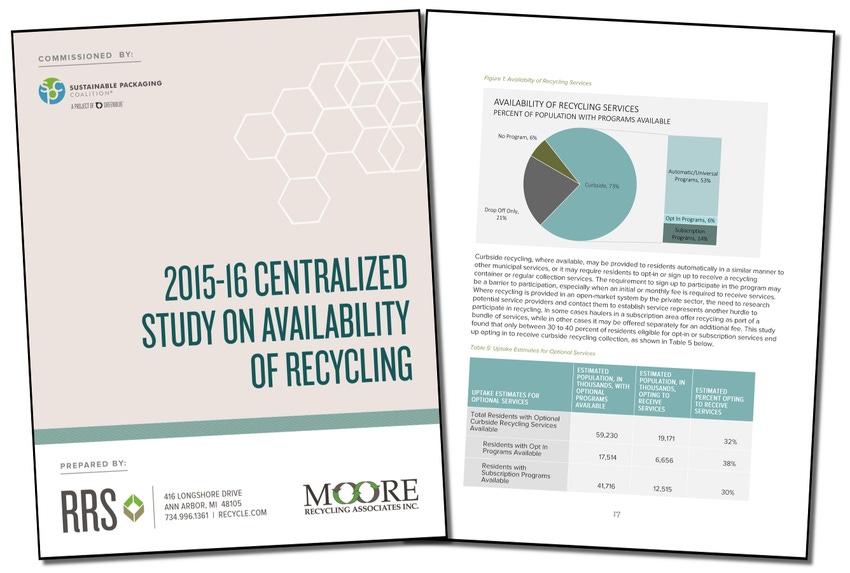New study helps answer the question 'Is this package recyclable?'
July 27, 2016

Everyone wants recyclable packaging, but the designation of “recyclable” can be complicated, subjective and often confusing. A new study released by the Sustainable Packaging Coalition (SPC) helps take the confusion out.
The 2015-16 Centralized Study on Availability of Recycling study, which was the collective effort of 13 packaging trade associations and recycling-focused non-profit groups, examined more than 2,000 American recycling programs and determined the acceptance of 49 types of packaging. For a package to deserve the “recyclable” designation, the SPC agrees with the U.S. Federal Trade Commission’s philosophy: To avoid greenwashing, there must be a strong likelihood the package will be recycled. This information on acceptance in the recycling bin is the important first step in understanding that likelihood.
The FTC’s Guide for the Use of Environmental Marketing Claims helps industry assess what level of acceptance in recycling programs is sufficient. The guide recommends a threshold of 60%, which means that if less than 60% of the population has an available program that accepts the item, then that lack of acceptance in collection programs should be considered a barrier to the practical recyclability of the item. However, if more than 60% of the population’s recycling programs accept the item, we can feel confident that collection is not a barrier.
The study found good news for a large number of major packaging types. With the exception of polyvinyl chloride (PVC) and polystyrene (PS), all plastic bottles, cups and rigid containers were found to be accepted in recycling programs available to more than 60% of the population. Aluminum beverage cans and glass bottles were found to be well over the 60% threshold. Aerosol containers (both steel and aluminum) also came in over 60%. Unsurprisingly, steel food cans also topped this list.
A number of packaging types were found to be accepted in the range of 20% to 60% range in our recycling programs. The acceptance of rigid polystyrene containers, polypropylene and polyethylene lids, aluminum foil food containers, bulky plastics and others must be improved before claims of recyclability can be made without an accompanying qualification regarding the lack of widespread acceptance in recycling programs. Aseptic and gable top cartons are a good example, with the study findings reinforcing the Carton Council’s imperative to push carton acceptance above 60% in the near future.
Other types of packaging need to see much more work done before the barrier of infrequent acceptance in recycling programs can be eliminated. Expanded polystyrene (EPS) packaging was found to be accepted in less than 20% of our population’s recycling programs, as were other harder-to-recycle items like paper ice cream tubs, plastic cutlery, paper cups, squeezable polyethylene tubes and paper containers for foodservice applications.
The standings of some types of packaging types with less than 60% acceptance might be improved with pursuits of community education. Some items may be perfectly acceptable in a recycling stream but not included in the list of acceptable items given to consumers. This must be addressed, so items that are otherwise compatible with the recycling process aren’t held up by their exclusion from collection programs.
For other items though, their underwhelming acceptance in recycling programs is reflective of real challenges in recycling processes. For their standings to improve, a combination of improvements to package design, recycling infrastructure and reprocessing technologies must be pursued, accompanied by an open and constructive dialogue with the recycling community. Once real change is brought about to improve the practical likelihood that the item will get recycled, acceptance in collection programs will follow.
For those packaging types that do enjoy an acceptance rate above 60%, it is important to remember that collection is only the first phase in the sequential process that is recycling. Put simply, acceptance in collection programs is the first step on the path towards a new life, but it is not the destination. The destination lies at the reprocessor, be that a steel mill, plastics reclaimer, glass plant, paper mill or aluminum mill.
What’s in between collection and the reprocessor? The material recovery facility (MRF), where an economically strained system does its best to sort out the most valuable materials. To assess the practical recyclability of an item and avoid greenwashing, there must also be confidence that the package will be correctly sorted, sold to a reprocessor, and ultimately deconstructed and reconstructed to become a new raw material with a new life.
Our study findings on acceptance in recycling programs are an important part of assessing recyclability. We would love to see equally rigorous and comprehensive studies conducted to understand success rates in MRFs and compatibility with reprocessing operations.
It is important to stress that the Centralized Study on Availability of Recycling research was not undertaken solely by the SPC, but instead represented a collective action taken by 13 of the leading organizations in packaging and recycling. This collaboration gives a loud statement that recyclability should be assessed on science and research, that the packaging industry ought to assess recyclability by the same metrics and that we should work together to improve our understanding of recycling.
We hope our study will find wide use in the packaging industry, and we hope it will spur several more collaborative efforts to research and improve the recyclability of packaging. Download the report for free here.

Author Adam Gendell is associate director of GreenBlue’s Sustainable Packaging Coalition and is responsible for orchestrating its fall conference, SPC Advance. For more information about the SPC, visit www.sustainablepackaging.org.
**************************************************************************
Looking for inspiration for your next sustainable packaging design project? Visit MinnPack 2016 (Sept 21-22; Minneapolis) for the latest in packaging materials, equipment, automation and more.
About the Author(s)
You May Also Like




